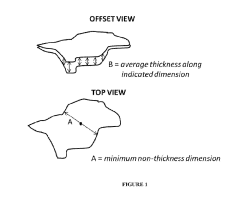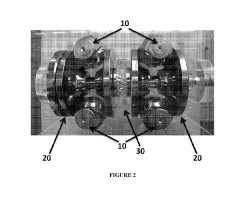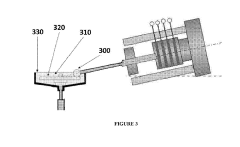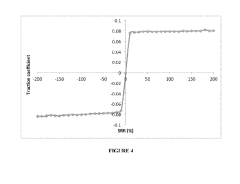Advanced Traction Fluids - Eureka
JUN 17, 20254 MIN READ
Generate Your Research Report Instantly with AI Agent
Patsnap Eureka helps you evaluate technical feasibility & market potential.
Advanced Traction Fluids Background and Goals
The primary objective is to provide a comprehensive overview of the development history and evolution trends in the field of advanced traction fluids. This section will delve into the key milestones and technological breakthroughs that have shaped the progress of this technology over time. Additionally, it will clearly define the expected technological goals and advancements that are anticipated to be achieved in the future.
By examining the historical trajectory and identifying the driving forces behind the advancements in advanced traction fluids, this section aims to establish a solid foundation for understanding the current state and future potential of this technology. It will serve as a crucial starting point for the subsequent analysis and exploration of market demands, technological challenges, and potential innovation pathways.
By examining the historical trajectory and identifying the driving forces behind the advancements in advanced traction fluids, this section aims to establish a solid foundation for understanding the current state and future potential of this technology. It will serve as a crucial starting point for the subsequent analysis and exploration of market demands, technological challenges, and potential innovation pathways.
Market Demand for High-Performance Traction Fluids
- Growing Demand for Efficiency
Traction fluids play a crucial role in enhancing the efficiency of mechanical systems. As industries strive for energy conservation and cost reduction, the demand for high-performance traction fluids that can improve equipment efficiency and reduce energy consumption is on the rise. - Stringent Environmental Regulations
With increasing environmental concerns, there is a growing need for traction fluids that are biodegradable, non-toxic, and have a low environmental impact. Stricter regulations on emissions and waste disposal are driving the demand for eco-friendly traction fluid solutions. - Expansion of Industrial Applications
The application of traction fluids is expanding beyond traditional industries like automotive and manufacturing. Emerging sectors such as renewable energy, aerospace, and robotics are creating new market opportunities for advanced traction fluids with specialized performance requirements. - Demand for Extended Service Life
Industries are seeking traction fluids with improved oxidation stability and thermal resistance to extend equipment service life and reduce maintenance costs. This demand is driven by the need for increased productivity and reduced downtime. - Global Market Growth
The global market for high-performance traction fluids is expected to experience significant growth in the coming years, driven by factors such as industrialization in emerging economies, technological advancements, and the adoption of sustainable practices.
Current State and Challenges in Traction Fluids
- Current Limitations Traction fluids face several challenges, including limited thermal stability, oxidation resistance, and load-carrying capacity, which can lead to premature degradation and reduced performance.
- Compatibility Issues Compatibility with various materials used in traction systems, such as seals and coatings, is a concern, as incompatibility can cause leakage, swelling, or corrosion.
- Environmental Concerns Many traditional traction fluids are derived from petroleum-based products, raising environmental concerns regarding their disposal and potential for contamination.
- Technological Advancements Emerging technologies, such as electric vehicles and advanced transmission systems, demand traction fluids with improved properties to meet higher operating temperatures and pressures.
Existing Solutions for Traction Fluid Optimization
01 Traction Fluids for Transmissions
Specialized lubricants designed for traction drive transmissions, employing rolling elements to transmit power through traction, providing optimal traction and lubrication properties.- Traction Fluids for Traction Drives: Specialized lubricants designed for traction drives, providing necessary traction and lubrication for efficient power transmission while minimizing wear and energy losses.
- Synthetic Hydrocarbon Traction Fluids: Synthetic hydrocarbon fluids, such as oligomers of cyclic hydrocarbons with olefins, offer excellent lubricating properties, thermal stability, and low traction characteristics for efficient power transmission and reduced energy losses.
- Low Traction Fluids: Formulated to have low traction characteristics, these fluids can reduce energy losses and improve efficiency in traction drive systems, often containing additives or specific molecular structures to lower the traction coefficient.
- Traction Devices and Enhancement: Various devices and systems designed to improve traction and grip on surfaces, including traction pads, pins, saddles, or media dispensing systems, enhancing traction and safety for vehicles or footwear.
- Traction Testing and Measurement: Devices and methods for testing and measuring traction coefficients or properties of materials or surfaces, such as apparatuses for testing traction coefficients, traction roller transmissions, or traction assemblies for specific applications.
02 Synthetic Hydrocarbon Traction Fluids
Synthetic hydrocarbon fluids, such as oligomers of cyclic hydrocarbons with olefins, used as traction fluids due to their excellent traction properties, low-temperature performance, and shear stability.Expand Specific Solutions03 Low Traction Fluids
Formulated to have low traction characteristics, these fluids can improve energy efficiency and reduce shudder in traction drive systems, often containing additives or specific base stocks.Expand Specific Solutions04 Traction Devices and Enhancement Systems
Various devices and systems designed to enhance traction for vehicles, footwear, or other applications, including traction pads, pins, media dispensers, and other mechanisms to improve grip and traction on various surfaces.Expand Specific Solutions05 Vehicle Traction Systems and Components
Essential components for vehicles, including traction drives, assemblies, saddles, and pins, playing a crucial role in transmitting power and providing traction for efficient vehicle operation.Expand Specific Solutions
Key Players in Traction Fluid Industry
The competitive landscape for advanced traction fluids involves established companies and educational institutions. Key players like Halliburton, Schlumberger, and Lubrizol lead with significant R&D investments. Universities like Southwest Petroleum and China Petroleum University Beijing contribute to research and development. The market is growing with increasing demand for efficient traction fluids across sectors. Companies like Schaeffler and Afton Chemical are making notable advancements as the technology matures.
Halliburton Energy Services, Inc.
Technical Solution: Halliburton develops advanced traction fluids to enhance drilling efficiency by reducing friction and wear in high-pressure environments, improving equipment performance and lifespan.
Strength: Proven effectiveness in high-pressure environments. Weakness: High cost of implementation.
Schlumberger Technologies, Inc.
Technical Solution: Schlumberger offers traction fluids engineered for superior lubrication and thermal stability in extreme conditions, ensuring consistent performance and reliability.
Strength: High thermal stability. Weakness: Limited availability in certain regions.
Core Innovations in Traction Fluid Formulations
Traction drive fluid
PatentActiveUS20190292485A1
Innovation
- The use of a carrier with specific boiling and melting points, the homogeneous distribution of the particulate solid within the carrier, and the high traction coefficient of the traction drive fluid.
Environmental Impact of Traction Fluids
Advanced traction fluids, also known as traction lubricants, are specialized lubricants designed for use in traction drive systems, such as toroidal continuously variable transmissions (CVTs) and traction drives. These fluids play a crucial role in ensuring efficient power transmission and prolonging the lifespan of traction components. The key aspects of advanced traction fluids include:
High traction coefficient: Traction fluids must exhibit a high traction coefficient to effectively transmit power between the contacting surfaces, enabling smooth and efficient operation of the traction drive system.
Thermal stability: Traction drives generate significant heat due to the high contact pressures and shear forces involved. Advanced traction fluids must maintain their viscosity and lubricating properties under elevated temperatures to prevent premature degradation and ensure consistent performance.
Low volatility: Traction fluids with low volatility minimize evaporative losses, reducing the need for frequent fluid replenishment and minimizing the risk of contamination or oxidation.
Compatibility with materials: Traction fluids must be compatible with the various materials used in traction drive components, such as metals, elastomers, and seals, to prevent corrosion, swelling, or degradation.
Advanced traction fluids often incorporate specialized additive packages tailored to meet the demanding requirements of traction drive systems, enhancing their performance, durability, and overall efficiency.
Regulatory Standards for Traction Fluids
Advanced traction fluids, also known as traction lubricants, are specialized lubricants designed for use in traction drives, such as toroidal and hydrostatic drives. These fluids play a crucial role in ensuring efficient power transmission and minimizing energy losses in these systems. The key aspects of advanced traction fluids include:
High traction coefficient: Traction fluids exhibit a high traction coefficient, enabling effective power transfer between the contacting surfaces, resulting in improved system efficiency and reduced energy losses.
Thermal stability: These fluids must maintain their viscosity and lubricating properties under high temperatures and pressures encountered in traction drives, ensuring reliable operation and extended component life.
Low volatility: Advanced traction fluids have low volatility, minimizing evaporative losses and reducing the need for frequent fluid replenishment, contributing to lower maintenance costs and environmental impact.
Compatibility: Compatibility with various materials used in traction drive components, such as seals and coatings, is essential to prevent degradation and ensure long-term performance.
The research on advanced traction fluids aims to develop formulations that enhance performance, durability, and energy efficiency while addressing environmental concerns and meeting evolving industry standards.
Unlock deeper insights with Patsnap Eureka Quick Research — get a full tech report to explore trends and direct your research. Try now!
Generate Your Research Report Instantly with AI Agent
Supercharge your innovation with Patsnap Eureka AI Agent Platform!



